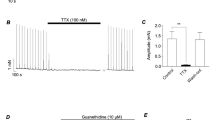Conclusions
-
1.
The vaospressin analog in most cases increased the excitability of command neurons of the defensive reflex inHelix lucorum.
-
2.
This effect is partially reversihle (it is abolished by rinsing out of the substance), but at least in the first stages, it is also cumulative on repeated applications of desglycine-arginine-vasopressin.
-
3.
The mechanism of this action of desglycine-arginine-vasopressin may consist of activation of a pacemaker mechanism and also of a change in the threshold of action potential generation.
Similar content being viewed by others
Literature cited
I. P. Ashmarin, “Oligopeptide modulators of memory and pain,” Zh. Evol. Biokhim. Fiziol.13, No. 5, 570 (1977).
V. M. Vinogradov, V. T. Medvedev, A. T. Grechko, V. D. Bakharev, and M. A. PonomarevaStepnaya, “Effect of polypeptide fragments of ACTE and vasopressin on behavioral activity in rats,” Fiziol. Zh. SSSR,66, No. 3, 409 (1980).
R. I. Kruglikov, B. L. Brodskii, O. Kh. Koshtoyants, M. Yu. Markarova, G. I. Chipens, and O. S. Papsuevich, “Effect of vasopressin analog on the chemoreactive properties of sensomotor cortical neurons,” Byull. Éksp. Biol. Med.,96, No. 10, 3 (1983).
R. I. Kruglikov, V. M. Getsova, K. Jost, O. S. Papsuevich, and G. I. Chipens, “Effect of vasopressin analogs on resistance of the temporary connection to extinction,” Izv. Akad. Nauk SSSR, Ser. Biol., No. 1, 145 (1985).
E. G. Litvinov and P. M. Balaban, “Endogenous potentials in the organization of the spike response of a neuron to a sensory stimulus,” Zh. Vyssh. Nerv. Deyat.,23, No. 6, 1313 (1973).
E. G. Litvinov and D. B. Logunov, “Changes in excitability of the command neuron in the initial period of conditioned reflex formation in the snail,” Zh. Vyssh. Nerv. Deyat.,29, No. 2, 284 (1979).
V. I. Medvedev, V. D. Bakharev, O. A. Kaurov, and T. K. Lozhkina, “Effect of genetically related neuropeptides of the posterior lobe of the pituitary gland and their analogs on learning and memory processes,” Zh. Evol. Biokhim. Fiziol.,17, No. 1, 41 (1981).
S. A. Osipovskii and M. M. Polesskaya, “Molecular mechanisms of participation of peptides in functions of nerve cells,” Usp. Fiziol. Nauk,13, No. 4, 74 (1982).
A. S. Pivovarov, “Induction of plastic changes of excitability of electrogenic neuronal membranes during habituation,” Zh. Vyssh. Nerv. Deyat.,33, No. 1, 138 (1983).
M. M. Polesskaya and S. A. Osipovskii, “Comparative analysis of the action of peptides and noradrenalin on an identified bursting snail neuron,” Dokl. Akad. Nauk SSSR,261, No. 6, 1496 (1981).
E. N. Sokolov, “The pacemaker potential in the organization of rhythmic activity of the neuron,” in: The Pacemaker Potential of the Neuron [in Russian], Metsniereba, Tbilisi (1975), p. 7.
J. L. Barker, M. Ifshin, and H. Gainer, “Studies on bursting pacemaker potential activity in molluscan neurons. III. Effects of hormones,” Brain Res.,84, No. 3, 501 (1975).
J. L. Barker and T. G. Smith, “Peptide regulation of neuronal membrane properties,” Brain Res.,103, No. 1, 167 (1976).
B. Bohus, R. Ader, and D. De Wied, “Effects of vasopressin on active and passive avoidance behavior,” Hormones Behav.,3, No. 1, 191 (1972).
B. Bohus, G. Kovacs, and D. De Wied, “Oxytocin, vasopressin and memory: opposite effects on consolidation and retrieval processes,” Brain Res.,157, No. 3, 414 (1978).
P. J. Delwaide, J. M. Devoitille, and M. Ylieff, “Acute effect of drugs upon memory of patients with senile dementia,” Acta Psychiat. Belg.,80, No. 5, 748 (1980).
D. De Wied and J. Jolles, “Neuropeptides derived from pro-opiocortin: behavioral, physiological and neurochemical effects,” Physiol. Rev.,62, No. 3, 976 (1982).
I. B. Levitan and S. N. Treistman, “Modulation of electrical activity and cyclic nucleotide metabolism in molluscan nervous system extract,” Brain Res.,136, No. 2, 307 (1977)
W. Lichtensteiger and D. Felix, “Vasopressin and ACTH 4-10: studies on individual giant dopamine neurons of the snailPlanorbis corneus,” in: Neuropeptides and Neural Transmitters, Proceedings of a UNESCO-IBRO Symposium, Jablonna, June 2–4, 1979, New York (1980), p. 333.
M. Muhlethaler, J. J. Dreifuss, and B. H. Gahwiller, “Vasopressin excites hippocampal neurones,” Nature,296, No. 5859, 749 (1982).
E. T. Walters, I. H. Byrne, T. Y. Carew, and E. R. Kandel, “Mechanoafferent neurons innervating tail of Aplysia. II. Modulation by sensitizing stimulation,” J. Neurophysiol.,50, No. 6, 1544 (1983).
Author information
Authors and Affiliations
Additional information
Translated from Zhurnal Vysshei Nervnoi Deyatel'nosti imeni I. P. Pavlova, Vol. 36, No. 6, pp. 1116–1124, November–December, 1986.
Rights and permissions
About this article
Cite this article
Kudryashova, I.V., Logunov, D.B. Action of vasopressin analog on neuronal excitability in helix lucorum. Neurosci Behav Physiol 17, 407–414 (1987). https://doi.org/10.1007/BF01188730
Received:
Issue Date:
DOI: https://doi.org/10.1007/BF01188730




